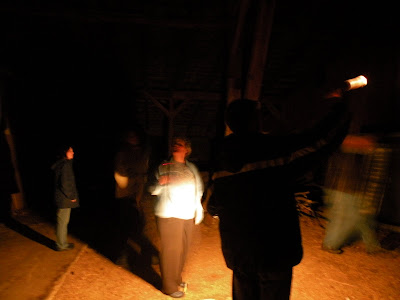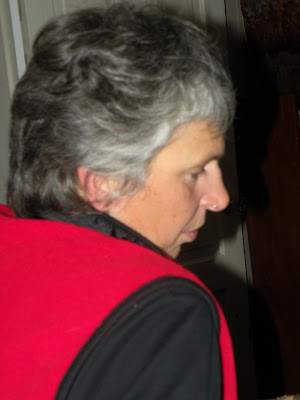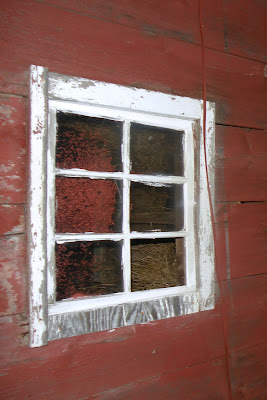 I talked with Tim Lind and his daughter, Rose, under the tall ceiling at the center of their home made from old barn beams on Tuesday, December 7, 2010. Though I had been in this home many times, I saw it in a sweep of seasons in the life of the trees that shaped it. The beams of this home have been recycled from an old barn in Ohio.
I talked with Tim Lind and his daughter, Rose, under the tall ceiling at the center of their home made from old barn beams on Tuesday, December 7, 2010. Though I had been in this home many times, I saw it in a sweep of seasons in the life of the trees that shaped it. The beams of this home have been recycled from an old barn in Ohio.


These beams have known three seasons.
In the spring of life, some three hundred years ago
they sprouted from maple wings, acorns, hickory nuts
walnuts, and cherry stones, in woods
walked by bare feet, moccasins, buck boots. They grew.
They forested what we now call Archibold, Ohio. Peoples
not like us later leaned on these towers of wood and searched
their leaf litter for nuts, mushrooms, the tracks of deer.
Some say these forests were so tall that Europeans
could ride through on horseback, the broad
trunks holding the tall canopies shading
out the undergrowth.

These giants become the timbers of summer, those
felled for barn beams for settlers some hundred
and fifty years gone. A man’s embrace could
just surround them before they fell. A horse
and team was needed to drag them, all thirty
and more feet in length, to be designed
into posts, beams, joints, elbows. Framed
in successive sections, laid one on the other,
the homestead community raising these beams,
made a barn in the mid-1800’s. A large barn. Strong.
For hay,straw, grain, cows, and horses. A barn that stood straight
and tall as timber.
Centuries move. Late summer, then fall. Family farms
fell; fields went fallow or for rent. Timbers,
barn timbers, stood silent. A huge
barn needing tending, painting, protection. Standing
alone in layers of additions. Beams mature and broad.
Fall in Three Rivers, Michigan: the Lind
land lay fallow. It too had seen seasons: forests
and wetland, corn field now empty, open to
dreams of Lind pines and cabins,
tee-pee dwelling, camping, and a green, green farm.
Trees, beams, posts, space,
salvage, soul. These were the calls
of fall that came. They lit imagination.
They opened books
on barns, joints and mortises. In
Pennsylvania, Tim Lind was taken, Yes.
He would build a post and beam house, no, home.
In balsa wood it began.

Friend, Sanford Wyse, in Ohio found
the Archibold barn and made the connection. So friends and their kids
gathered for one hot summer week, and down the beams came,
beams sprung from spring, beams
that had stood hot the summers of farm shelter,
the boards of oak siding –
these all came
down. And onto
a semi-
truck they moved
and entered the fall
season of Harder Road,
Michigan, the Land of Linds.
Under the cover of tarpaulin and snow, submerged
in a hole of creation with hand tools
alone, Tim labored in contemplation, chiseling
each joint, the geometry
figured through winter. (Though this was only
a pre-sage of winter, the last winter, to come. )

Before fall came once more
just a year later, these timbers,
re-fashioned in dove joints and angles
arose. Once more in successions of people
and pulleys, these trees were reborn from a barn to
a home. The photos proclaim it: a barn-
home is rising! See kids perched on new beams. New bones
of the skeleton now only await new skin,
new life, new breath, warmth and, yes, food.

Friend after friend, soulmates over seasons,
with Tim placed each floor board, cupboard, windows, the doors.
Then a family of eight each had room, all and one.
A family keeps growing while boards settle down.

While warmth glows through snowfall, it is not the beams' winter.
The life of this structure is vibrant and beaming.
Family flocks here, all for Christmas.
A new tree is felled for the Christ,
a small gift. Warmed by wood fire from trees of this land
the high ceiling beams show, new timber
is standing around yet to build on and on.
“What of the future,
the winter ahead?” It is this yet I wonder…

Tim notes successions of trees in the woodland.
White oak stands shift to soft maples. Wetlands
rise, killing the maples, the next season
to fall allowing the maples to spring up again.
The land has its way, its wisdom, its shaping.
“I am not shaping the land, but only
part of the shaping.” Beams aren’t forever.
People will be in this place at the decay
of beams that were sprouted among people long gone.
Light years it takes to beam food to each tree leaf.
Light casts on snow beams from home, never complete.





















































